I was once married to a man who had cancer. (Don’t worry, it’s not that kind of story: cancer didn’t kill the marriage, his infidelities did). The man began to unravel at the diagnosis; in an effort to give him a sense of control over his cancer, I suggested we go on a macrobiotic diet.
I didn’t think then any more than I do now that there is a scientific reason for following a macrobiotic diet when one has cancer. But the man with cancer embraced it as a way to fight his disease, and for that it was useful.
It wasn’t very tasty. No nightshades (sayonara, my beloved tomatoes and red bell peppers!), no dairy (soy substitutes for cheese and ice cream- ugh), no meat or poultry, and no cookies (or cakes or Swedish fish candy!). A macrobiotic diet has some inherent health benefits: it is generally low in fat and high in certain important nutrients (though often lacking in others). About half the calories come from whole grains and the rest from vegetables, legumes, seaweed, nuts and seeds, and an occasional piece of fish. I survived an entire year without a single tomato nor the tiniest little lick of butter.
I learned a great deal about grains that year. (And about a whole lot more, but that is a story for another time). Long before anyone knew how to pronounce this odd little grain (keen-wa) and more than a decade before it appeared on my grocery store shelf, I went to the library (that’s how long ago it was) to research how to cook it.
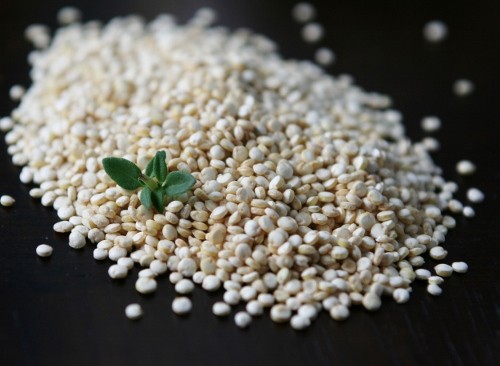
That little thyme leaf isn't there to pretty up the picture: it is to show you how tiny the grain is
I’m glad I did: I love quinoa to this day. I love its funny little crunch, sperm-like shape, and nutty flavor. I also love that this ancient Incan grain is higher in both protein and fiber than most whole grains. (While the calories are comparable at about 220 per cup, a cup of cooked quinoa has 8 grams of protein while brown rice has five; quinoa has 5 grams of fiber and brown rice has four.)
It used to be quinoa had to be thoroughly rinsed before cooking to remove its bitter flavor, but many brands, including Bob’s Red Mill and Ancient Harvest, now sell it pre-rinsed. It’s not a big deal if you need to rinse it, though. Just measure the amount you want to cook, dump it in a fine mesh strainer, and run it under cold water, shaking around the grains until they are thoroughly rinsed.
I not only make quinoa as a side dish with dinner, but also to serve at parties, where it looks and holds beautifully on a buffet.
[print_this]
Quinoa with Dried Apricots and Cherries with Cumin Vinaigrette
1 cup quinoa
2 cups water
1/4 cup dried apricots (about 10), chopped
1/4 cup dried cherries
1 tablespoon lemon juice
1/4 teaspoon ground cumin
1/2 teaspoon salt
Pinch ground cayenne (less than 1/8 teaspoon…you can always add more)
3 tablespoons extra virgin olive oil
1/2 cup minced red onion
1/4 cup parsley, chopped
1 tablespoon fresh mint, chopped
1/2 teaspoon fresh thyme, chopped (or 1/4 teaspoon dried)
- Rinse the quinoa if necessary; combine with the water in a medium saucepan and bring to a boil. Immediately reduce heat, add the apricots and cherries to the pot, cover and simmer gently until the liquid is absorbed, about 20 minutes.
- Meanwhile, make the dressing: whisk the lemon juice, cumin, salt, cayenne and olive oil together in the bowl in which you will serve the quinoa. Add the quinoa, onion, parsley, mint and thyme and toss thoroughly. Serve warm or at room temperature.
Makes 6 servings
228 calories, 5 g protein, 32 g carbohydrates, 3 g fiber, 9 g fat, 1 g saturated fat, 199 mg sodium
[/print_this]
You can find quinoa at almost any grocery store, or on Amazon. I’ve used Bob’s Red Mill (pictured above right), Ancient Harvest, Village Harvest (pictured above left), Eden, and Arrowhead with equal success. I generally now look for pre-rinsed quinoa (might as well save the step)– it will be clearly marked as such on the label.
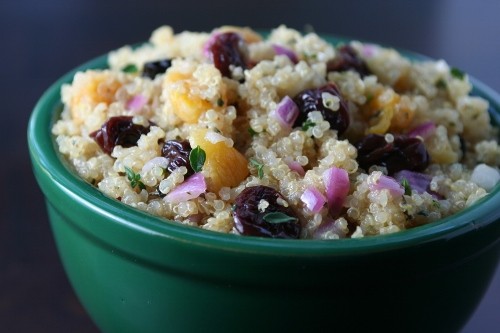
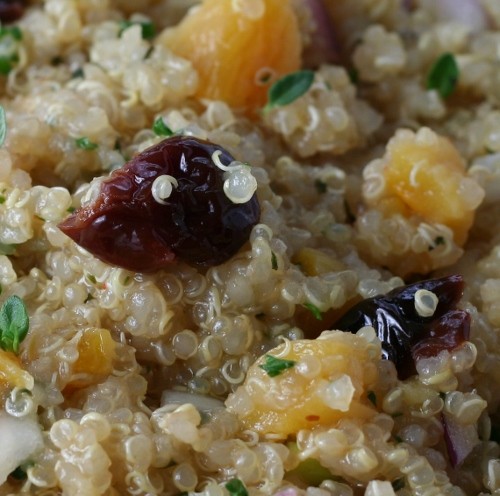
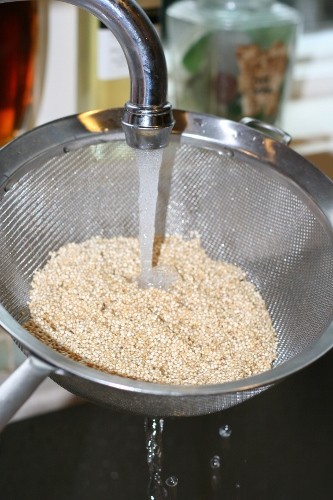
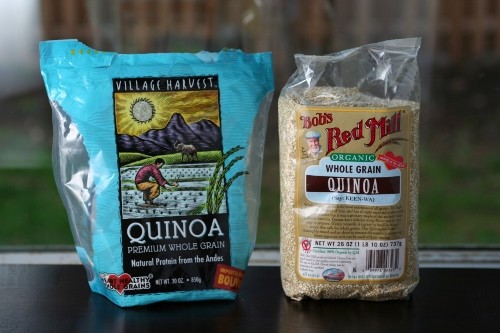
nom nom nom.
I learned to (poorly) cook quinoa when I went vegan for a year. I will send this recipe on to my vegany friends!
Sydney– Thanks! Those vegany friends of yours might want to check out the recipes (on the Side Dishes page) for quinoa dishes with a little more protein, too. There are two recipes with almonds in them and one with edamame.
Hi Marge,
Looks like there is an unfinished thought at the end of your blog re Quinoa of today.
You have a “Note” for those who might be preparing the dish in advance BUT no clarification. Could you please pass on your complete thought. Thanks.
Tom, thanks so much for catching this. Yup, I managed to leave off the instructions for making the dish in advance.
As the quinoa sits, it absorbs the dressing, so if you make it several hours ahead, brighten it up just before serving with a little additional lemon juice (about 1 teaspoon) and a pinch of salt and cumin.
fabulous looking and sounding. So excited to speak with you next month at BlogHer Food and get to know you better!
We’ll have a blast– and Katie too. I’m really looking forward to the conference, to getting to meet you in person, and to speaking on the panel with you. Now “y’all” just take care of yourselves in the aftermath of that awful storm! I hope you didn’t suffer much damage…
My sister served this at dinner last night, and it was a big hit. I’m adding it to my own repertoire… thanks!
You have red onion and olive oil on the ingredient list but you don’t have in the directions what to do with them. Can you clarify? Thanks for sharing!
Thank you for catching that! I have fixed it, and I checked my nutritional numbers and they are correct as is.
Re-hi!
Is the mint super important? I hate to buy it for only one recipe. Even if I can find it in my little town I wouldn’t know what to do with the rest of it. It seems like such a waste to only use it the once.
Please, no need to answer if you’re too busy. I totally understand that time is so very precious.
Hi Angela– I love the flavor of mint in this dish, but the answer is this simple: I would also love this dish without the mint. For what it is worth, I would be just as likely to leave it out if I had all the other ingredients on hand as I would be to replace it with fresh basil or cilantro, if that was what I had in my fridge (or growing in my garden). Let me know what you think!